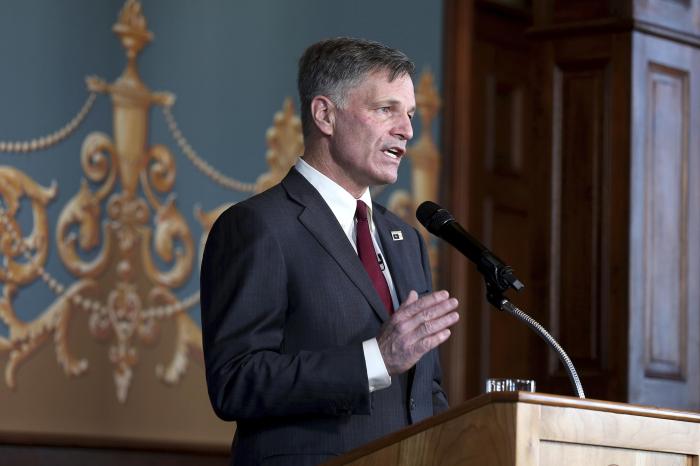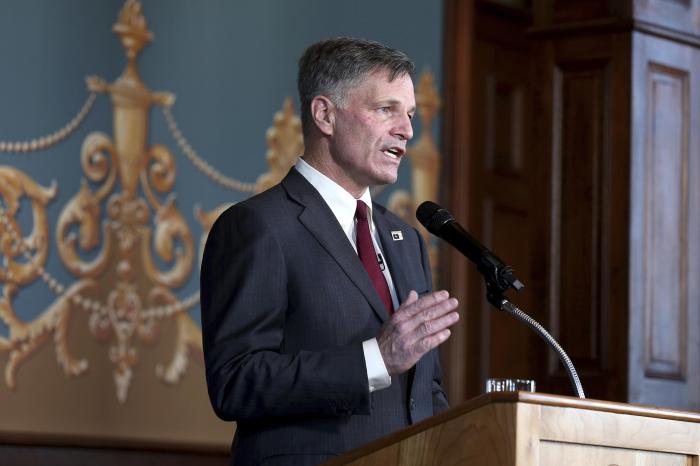
Live Updates: Wyoming & Alaska Midterm Primary Results
Live updates wyoming and alaska midterm primary results are in, and the political landscape in these two states is shifting. Voters across Wyoming and Alaska headed to the polls to cast their ballots in a series of competitive races, shaping the direction of the upcoming general elections.
These primaries offer a glimpse into the priorities and preferences of voters in both states, providing insights into the key issues that will likely dominate the political discourse in the months ahead. From hotly contested gubernatorial races to key congressional seats, the results of these primaries have significant implications for the future of both states.
With the dust settling, the focus now shifts to analyzing the results and understanding their potential impact on the general election. We’ll delve into the key races, the performance of major candidates, and the surprising outcomes that emerged from these primaries.
Additionally, we’ll examine voter turnout and demographic trends, offering a deeper understanding of the electorate in Wyoming and Alaska. Stay tuned as we break down the key takeaways from these crucial elections.
Wyoming and Alaska Midterm Primary Elections Overview

The Wyoming and Alaska midterm primary elections, held on August 16, 2022, were significant events in the lead-up to the November general elections. These primaries attracted national attention due to the high-profile races and their potential impact on the national political landscape.
Key Races and Significance
These primaries were particularly significant for both states due to the high-profile races and their potential impact on the national political landscape.
- In Wyoming, the Republican primary for the U.S. House of Representatives attracted national attention as incumbent Liz Cheney, a vocal critic of former President Donald Trump, faced a primary challenge from Harriet Hageman, a Trump-endorsed candidate. Cheney ultimately lost the primary, highlighting the continued influence of Trump within the Republican Party.
- In Alaska, the primary for the U.S. House of Representatives featured a ranked-choice voting system, which allowed voters to rank candidates in order of preference. This system, implemented in Alaska in 2020, aimed to promote more moderate candidates and reduce the influence of extreme views.
Sarah Palin, a former governor of Alaska and a prominent figure in the Tea Party movement, was among the candidates in this race. She ultimately lost the primary to incumbent Representative Mary Peltola, a Democrat, in a close race.
Wyoming Primary Results
Wyoming’s primary election saw a number of notable races, with the Republican Party’s nomination for the U.S. Senate drawing the most attention. Incumbent Senator Cynthia Lummis, who was elected in 2020, faced a challenge from several candidates, including former Wyoming Secretary of State Ed Buchanan.
Key Results
Wyoming voters overwhelmingly chose Lummis to run for reelection. Lummis won with a commanding lead, capturing over 70% of the vote. Buchanan came in second place with approximately 15% of the vote.
Alaska Primary Results: Live Updates Wyoming And Alaska Midterm Primary Results
Alaska’s primary election saw a flurry of activity as voters narrowed down the field for the general election in November. The state’s unique ranked-choice voting system added an extra layer of complexity to the process, with candidates vying for top spots and voters strategically ranking their choices.
Key Results
The most notable outcome was the Republican primary for U.S. Senate, where incumbent Senator Lisa Murkowski faced a tough challenge from Kelly Tshibaka, a former commissioner of the Alaska Department of Administration. Murkowski, a moderate Republican, has been a target of the Trump-aligned wing of the party.
Tshibaka, endorsed by former President Donald Trump, campaigned on a platform of conservative values and a commitment to “draining the swamp” in Washington. In the end, Murkowski emerged victorious, securing enough votes to avoid a runoff election. While Tshibaka received a significant share of the vote, Murkowski’s strong performance suggests that she remains popular among Alaskan voters.
Performance of Major Candidates
- In the race for Alaska’s lone U.S. House seat, incumbent Republican Don Young, the longest-serving member of the House, faced a primary challenge from several candidates, including former Governor Sarah Palin. Young ultimately prevailed, but the results suggest that his grip on the seat may be loosening.
Palin, who was seeking a return to politics after a decade away, received a significant number of votes, indicating that she remains a force to be reckoned with in Alaska politics.
- The Alaska governor’s race saw a crowded field of candidates from both major parties. Republican Mike Dunleavy, the incumbent governor, faced a primary challenge from several candidates, including former governor Bill Walker. Dunleavy ultimately secured enough votes to avoid a runoff election, but the results suggest that he may face a close race in the general election.
While we’re glued to the live updates from Wyoming and Alaska’s midterm primary results, a shocking incident unfolded in the Bronx, where a woman tragically fell through her apartment floor into the cellar. Thankfully, the New York City DOB is investigating the cause of this terrifying event, new york city dob investigating after woman falls through apartment floor into cellar in the bronx and hopefully, we’ll get answers soon.
But for now, let’s get back to the nail-biting political race in Wyoming and Alaska!
Unexpected Outcomes
The primary election in Alaska saw several surprises, including the strong performance of independent candidate Alyse Galvin in the U.S. Senate race. Galvin, a former state representative, campaigned on a platform of progressive values and a commitment to addressing climate change.
While she ultimately fell short of advancing to the general election, her strong showing suggests that there is a significant appetite for independent candidates in Alaska.
While we wait for the final results of the Wyoming and Alaska midterm primary elections, news from Florida is making headlines. Governor Ron DeSantis’ election police force has announced the arrests of 20 individuals for voter fraud, as reported in this article.
This development raises questions about the integrity of elections and the role of law enforcement in ensuring fair voting practices, while the races in Wyoming and Alaska continue to unfold.
Voter Turnout and Demographics
Voter turnout in the Wyoming and Alaska midterm primary elections was relatively low compared to previous elections. This is likely due to a combination of factors, including the non-presidential nature of the election cycle and the ongoing COVID-19 pandemic.
Voter Turnout in Wyoming and Alaska Primaries
Voter turnout in the Wyoming primary election was significantly lower than in previous elections. According to the Wyoming Secretary of State, only 35% of registered voters cast ballots in the 2022 primary, compared to 42% in the 2018 primary.
It’s been a wild ride following the live updates for the Wyoming and Alaska midterm primary results. The political landscape is shifting rapidly, and it’s hard to predict who will come out on top. All this while the drama in the EU continues to unfold, with the question on everyone’s mind: will Breton’s final salvo rock von der Leyen’s boat even further?
This article dives into the potential impact of Breton’s actions. But back to the primaries, I’m sure we’ll see some surprising outcomes as the night progresses.
This decline in turnout can be attributed to several factors, including the absence of a high-profile race for governor or senator. In Alaska, voter turnout was also lower than in previous primaries. The Alaska Division of Elections reported that 45% of registered voters participated in the 2022 primary, compared to 52% in the 2018 primary.
The decline in turnout can be attributed to the state’s new ranked-choice voting system, which may have confused some voters.
Demographic Trends in Voter Participation, Live updates wyoming and alaska midterm primary results
While overall voter turnout was lower in both states, there were some notable demographic trends in voter participation. In Wyoming, for example, Republican voters were more likely to participate in the primary than Democratic voters. This is likely due to the fact that the Republican primary featured a number of high-profile races, including the race for the U.S.
House of Representatives.In Alaska, there was a significant gender gap in voter turnout. Women were more likely to participate in the primary than men. This is likely due to the fact that the primary featured a number of races that were of particular interest to women, such as the race for the U.S.
Senate.
Impact on General Election

The Wyoming and Alaska primary results have significant implications for the upcoming general election. The candidates who emerged victorious in the primaries will now face off in November, with the potential to shape the political landscape in both states.
Key Races to Watch
The primary results have narrowed the field of candidates in key races, setting the stage for intense general election contests. These races are likely to attract national attention and could have a significant impact on the balance of power in Congress and state government.
- Wyoming’s lone House seat: The Republican primary for Wyoming’s sole House seat saw a crowded field of candidates vying for the nomination. The winner of this primary will face a Democratic challenger in the general election, with the outcome likely to depend on the candidate’s ability to mobilize the Republican base and appeal to independent voters.
- Alaska’s Senate race: The Alaska Senate race is another key contest to watch. The Republican primary saw several candidates vying for the nomination, with the winner facing an uphill battle against the Democratic incumbent in the general election. The outcome of this race could have a significant impact on the balance of power in the Senate.
- Governor’s races: Both Wyoming and Alaska will hold gubernatorial elections in November. The primary results have set the stage for competitive races in both states, with the outcome likely to depend on the candidates’ ability to address key issues such as the economy, energy, and education.
Potential Impact on the Political Landscape
The primary results in Wyoming and Alaska could have a significant impact on the political landscape in both states. In Wyoming, the Republican Party remains dominant, and the primary results suggest that the party is likely to maintain its grip on power in the state.
However, the outcome of the gubernatorial race could be closer than expected, as the Democratic challenger may be able to capitalize on concerns about the state’s economy and the Republican incumbent’s handling of the COVID-19 pandemic.In Alaska, the political landscape is more fluid.
The primary results suggest that the Republican Party may be losing its grip on power in the state, as several Democratic candidates performed well in the primaries. The outcome of the Senate and gubernatorial races will be closely watched, as they could provide insights into the future of the Republican Party in Alaska.
Key Issues and Debates
The Wyoming and Alaska midterm primary elections were marked by a number of key issues and debates that reflected the concerns of voters in each state. These issues ranged from the economy and energy to social and cultural values, and they played a significant role in shaping the political landscape of the primaries.
Economic Issues
Economic issues were a major focus in both Wyoming and Alaska, as voters grappled with the impact of inflation and the rising cost of living. In Wyoming, the state’s reliance on the energy industry made the issue of energy development and the transition to renewable energy sources particularly salient.
The debate over the future of fossil fuels and the potential for economic diversification was central to the primary campaigns.
- Energy Development:Wyoming’s economy is heavily reliant on fossil fuels, particularly coal. The state’s primary election saw candidates debate the future of the energy industry, with some advocating for continued development of fossil fuels and others emphasizing the need for a transition to renewable energy sources.
- Economic Diversification:Voters in Wyoming expressed concerns about the state’s economic dependence on the energy industry and the need for diversification. Candidates discussed the importance of attracting new businesses and industries to the state to create jobs and stimulate economic growth.
In Alaska, the high cost of living and the state’s dependence on oil revenues were major concerns. Candidates discussed the need for fiscal responsibility, the potential for economic diversification, and the role of government in addressing the cost of living crisis.
- Cost of Living:The high cost of living in Alaska was a major concern for voters. Candidates discussed the need for policies to address the issue, such as tax breaks, subsidies, and affordable housing initiatives.
- Oil Revenue:Alaska’s economy is heavily reliant on oil revenues. The state’s primary election saw candidates debate the future of the oil industry, with some advocating for continued development and others emphasizing the need for diversification and alternative sources of revenue.
Social and Cultural Issues
Social and cultural issues also played a significant role in the Wyoming and Alaska primaries. These issues included abortion rights, gun control, and education.
- Abortion:The issue of abortion rights was a major focus in both states. Candidates discussed their positions on abortion access, with some supporting restrictions and others advocating for abortion rights.
- Gun Control:Gun control was another important issue in both states. Candidates discussed their positions on gun laws, with some advocating for stricter regulations and others opposing any restrictions on gun ownership.
- Education:Education was a significant issue in both states, with candidates discussing their positions on school funding, curriculum, and teacher salaries.






